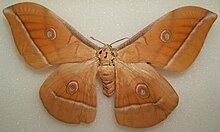
Back Antheraea pernyi Catalan Antheraea pernyi CEB Chinesischer Eichenseidenspinner German Antheraea pernyi Spanish Kiinantammisilkkikehrääjä Finnish Ver à soie tussah French Antheraea pernyi Interlingua ჩინური მუხის აბრეშუმხვევია Georgian Емен жібек көбелегі Kazakh 산누에나방 Korean
| Antheraea pernyi | |
|---|---|

| |
| Mounted female | |

| |
| Living specimen | |
| Scientific classification | |
| Domain: | Eukaryota |
| Kingdom: | Animalia |
| Phylum: | Arthropoda |
| Class: | Insecta |
| Order: | Lepidoptera |
| Family: | Saturniidae |
| Genus: | Antheraea |
| Species: | A. pernyi
|
| Binomial name | |
| Antheraea pernyi (Guérin-Méneville, 1855)
| |
| Synonyms | |
| |
Antheraea pernyi, the Chinese oak tussar moth, Chinese tasar moth or temperate tussar moth, is a large moth in the family Saturniidae. The species was first described by Félix Édouard Guérin-Méneville in 1855. Antheraea roylei is an extremely close relative, and the present species might actually have evolved from ancestral A. roylei by chromosome rearrangement.[1][2]
They are originally from southern China. Used for tussar silk production, they have been distributed more widely across subtropical and tropical Asia. Unlike the domestic silk moth which is entirely dependent on human care, tussah silk moths can survive in the wild if they escape from captivity; small local populations of such feral stock may thus occasionally occur. The colour and quality of the silk depends on the climate and soil.[3]
This is one of the major producers of tussar silk.[4] It was of commercial importance during the Han dynasty and early Three Kingdoms era, about 200 BC to 250 AD. More recently, the hybridogenic species Antheraea × proylei is being bred for tussah silk production. It originated from a natural hybrid between male A. pernyi and A. roylei females, F1 females of which were backcrossed to A. pernyi males. For reasons unknown, it is a case of paternal mtDNA transmission: the mitochondrial genome, normally inherited from the mother only in sexually reproducing organisms, is almost identical to that of the present species.[1]
This silkworm is raised in China for its silk. It is referred to as tussah, Chinese tussah, oak tussah, or temperate tussah. It is the source of tussah spinning fiber that is used in the West. It is a relative of the tropical tussah silk moth, Antheraea paphia of India, and also related to Antheraea polyphemus, the American polyphemus silk moth. In China, they are fed on plantations of specially trimmed oak trees on the hillsides.[5]
- ^ a b Arunkumar, K.P.; Metta, Muralidhar; Nagaraju, J. (August 2006). "Molecular phylogeny of silkmoths reveals the origin of domesticated silkmoth, Bombyx mori from Chinese Bombyx mandarina and paternal inheritance of Antheraea proylei mitochondrial DNA". Molecular Phylogenetics and Evolution. 40 (2): 419–427. doi:10.1016/j.ympev.2006.02.023. PMID 16644243.
- ^ Peigler, Richard S. "Diverse evidence that Antheraea pernyi (Lepidoptera: Saturniidae) is entirely of sericultural origin". Tropical Lepidoptera Research. 22 (2): 93–99.
- ^ "Chapter 9". Fao.org. Archived from the original on 2012-10-21. Retrieved 2011-10-18.
- ^ Li, Wenli; Zhang, Zhengyao; Lin, Lan; Terenius, Olle (1 August 2017). "Antheraea pernyi (Lepidoptera: Saturniidae) and Its Importance in Sericulture, Food Consumption, and Traditional Chinese Medicine". Journal of Economic Entomology. 110 (4): 1404–1411. doi:10.1093/jee/tox140. ISSN 0022-0493. PMID 28535207.
- ^ "Antheraea pernyi, Chinese Oak Tasar Silkworm". www.wormspit.com. Retrieved 11 July 2019.
© MMXXIII Rich X Search. We shall prevail. All rights reserved. Rich X Search